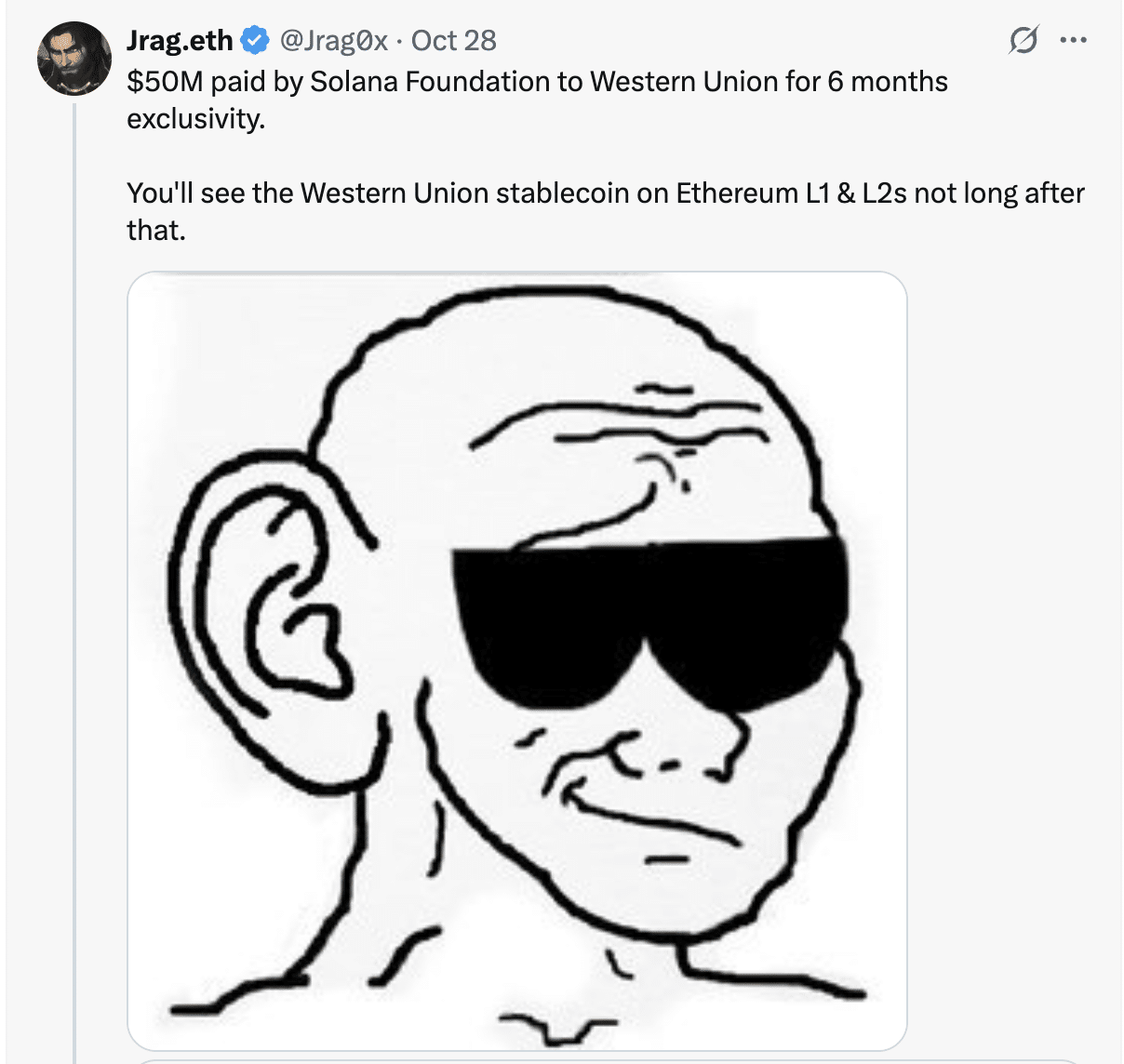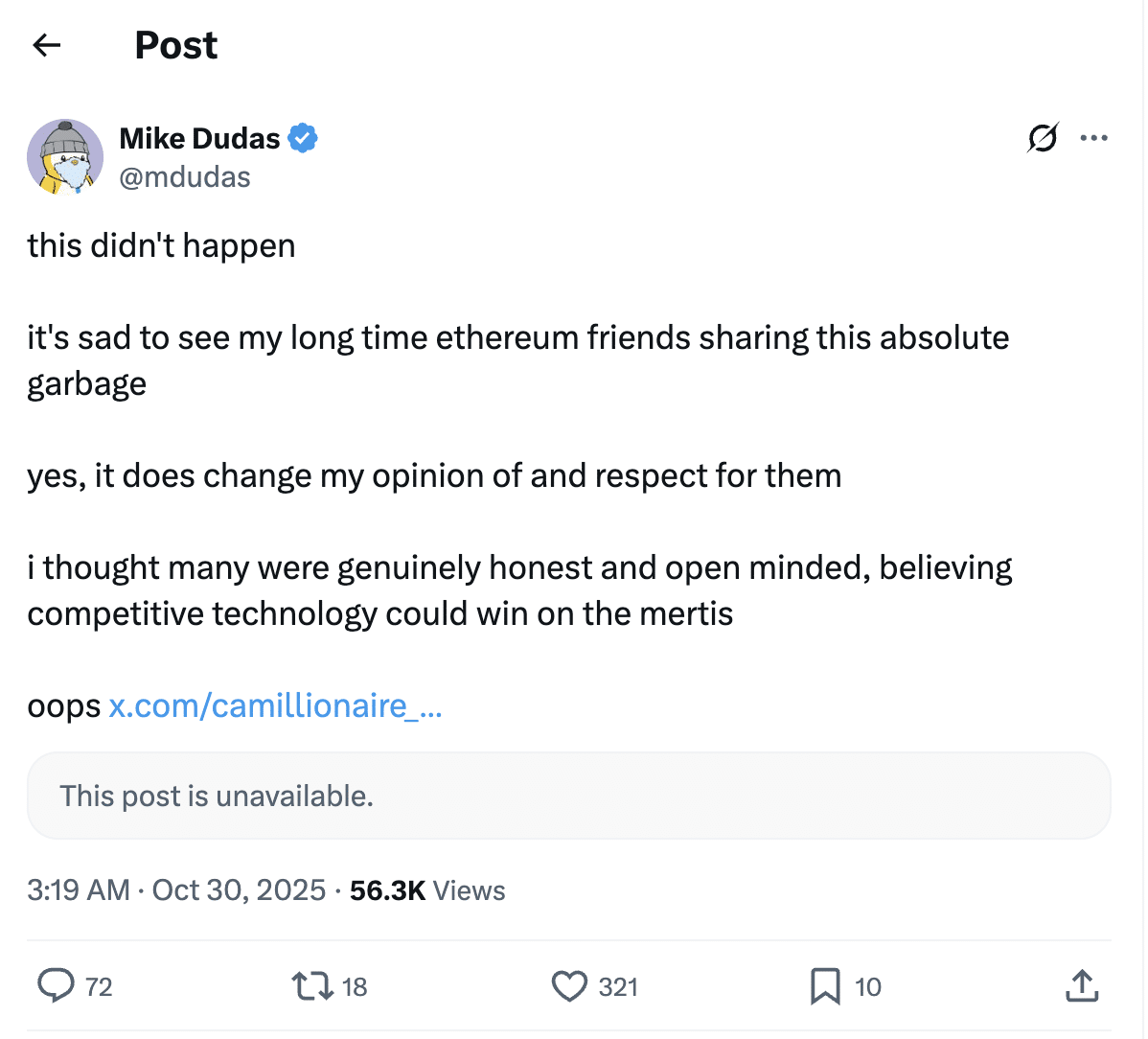Western Union is launching a U.S. dollar-backed stablecoin on Solana in early 2026 to enhance global payments, amid unverified rumors that Solana paid for temporary exclusivity. The partnership leverages Solana’s speed and low costs for over 100 million customers.
-
Western Union partners with Solana for USDPT stablecoin launch
-
Anchorage Digital will issue the token, integrating it into Western Union’s network across 200+ countries
-
Social media claims allege $25-50 million payment for six-month exclusivity, though unconfirmed
Discover Western Union Solana stablecoin details and rumors of exclusive payments. Explore the partnership’s impact on crypto adoption. Stay updated on blockchain innovations today.
What is the Western Union Solana stablecoin partnership?
Western Union Solana stablecoin partnership involves the financial giant launching the U.S. Dollar Payment Token (USDPT) on Solana’s blockchain in early 2026. This initiative aims to streamline cross-border payments using blockchain technology. Anchorage Digital Bank will issue the token, allowing Western Union to serve its vast customer base more efficiently with low-cost, high-speed transactions.
How did rumors of Solana paying for exclusivity emerge?
The rumors surfaced shortly after Western Union’s announcement on October 28, 2025, when social media users speculated about financial incentives from the Solana Foundation. Claims circulated that Solana allegedly paid between $25 million and $50 million for six months of exclusive use before expanding to other networks like Ethereum. These assertions, often shared on platforms like X, lack official confirmation from involved parties. Industry experts point out that such incentives are common in blockchain ecosystems to boost adoption. For instance, Western Union CEO Devin McGranahan highlighted Solana’s infrastructure as the deciding factor, emphasizing technical merits over any undisclosed deals. According to reports from blockchain analysts, partnerships like this often involve grants, but specifics remain private.
Frequently Asked Questions
Did Solana really pay Western Union for the stablecoin exclusivity?
No verified evidence supports claims that Solana paid Western Union for exclusivity on the USDPT stablecoin. Social media posts alleged a $25-50 million deal for six months, but statements from Western Union, Solana, and Anchorage Digital describe the partnership as based on shared vision and technology. Blockchain foundations commonly offer incentives, yet this remains unconfirmed speculation.
Why choose Solana for Western Union’s stablecoin over other blockchains?
Western Union selected Solana due to its high-speed, low-cost infrastructure, ideal for global payments. The network processes thousands of transactions per second at fractions of a cent, outperforming many rivals in scalability. As Solana’s head of payments, Sheraz Shere, stated, this partnership validates Solana’s capabilities for real-world financial applications, making it a natural fit for serving over 100 million customers.
Key Takeaways
- Strategic Partnership Launch: Western Union plans to introduce the USDPT stablecoin on Solana in early 2026, enhancing payment efficiency for its global network.
- Unverified Rumors: Social media claims of a $25-50 million exclusivity payment from Solana lack official backing, highlighting common industry practices.
- Blockchain Competition: The deal underscores rivalries, with critics arguing it’s “bought” adoption, while supporters emphasize Solana’s technical strengths.


Source: X
The Solana Partnership Details
On October 28, 2025, Western Union revealed its intention to launch the U.S. Dollar Payment Token (USDPT) on Solana’s blockchain, scheduled for early 2026. This move positions the century-old remittance company at the forefront of blockchain integration in traditional finance.
Anchorage Digital Bank, a federally chartered institution specializing in digital assets, will handle the token issuance. Western Union plans to weave USDPT into its extensive payment ecosystem, which spans over 200 countries and caters to more than 100 million users annually. This integration promises faster settlement times and reduced fees compared to conventional methods.
Western Union CEO Devin McGranahan underscored Solana’s advantages, stating that its “high-speed, low-cost infrastructure” enables seamless global transactions. Similarly, Sheraz Shere, Solana’s head of payments, described the collaboration as a milestone affirming the platform’s readiness for enterprise-scale applications. Data from Solana’s network shows it handles up to 65,000 transactions per second, far surpassing many competitors in efficiency.
The Rumors Take Hold
Speculation erupted almost immediately following the announcement, with users on social media platforms alleging that the Solana Foundation provided substantial financial incentives to secure the deal. The purported arrangement reportedly involved payments ranging from $25 million to $50 million, granting Solana six months of exclusive rights before USDPT could migrate to other chains like Ethereum.
Posts on X amplified these narratives, including one that read: “$50M paid by Solana Foundation to Western Union for 6 months exclusivity.” Another asserted: “The deal is locked for 6 months only.” These claims proliferated without substantiation, fueling debates across crypto communities.
The speculation particularly resonated among advocates of rival blockchains, such as XRP supporters, who portrayed the partnership as Solana resorting to financial inducements rather than relying on inherent technological superiority. This framing intensified tribal divisions within the crypto space, where major announcements often ignite competitive discourse.
Community Reactions
Defenders of Solana swiftly rebuffed the allegations, labeling them unfounded and driven by envy. Mert Mumtaz, CEO of Helius—a prominent Solana infrastructure provider—emphasized that Western Union conducted thorough evaluations of various blockchains and opted for Solana based on performance metrics alone.
Ryan Wyatt, former President of Polygon, added perspective by noting that funding partnerships is a standard strategy across the blockchain sector. He observed that foundations routinely allocate resources for grants, liquidity provisions, and collaborations to foster ecosystem growth. Wyatt’s comments, drawn from his extensive experience in Web3, illustrate how such practices normalize competitive dynamics without implying impropriety.
Opponents maintained that these incentives mask underlying weaknesses, yet proponents highlighted Solana’s proven track record, including partnerships with major firms like Visa and Shopify. The exchange underscores the passionate nature of crypto communities, where unverified rumors can overshadow factual developments.


Source: X
Critics argued that such arrangements are routine in the cutthroat blockchain arena, where ecosystems vie for dominance through targeted investments. This perspective aligns with observations from firms like Deloitte, which report that over 70% of blockchain partnerships involve some form of financial support to mitigate adoption risks.
What We Know for Certain
To date, neither the Solana Foundation, Western Union, nor Anchorage Digital has addressed the payment rumors directly. Western Union’s press release focused solely on a “shared vision” for innovative payments, omitting any mention of financial specifics.
Analysts from authoritative sources like CoinDesk and Bloomberg note that temporary exclusivity deals, if existent, would fit established patterns in the industry. Blockchain foundations, including those of Ethereum and Binance Smart Chain, have historically deployed millions in incentives to secure high-profile integrations.
The controversy sheds light on persistent frictions among blockchain networks, where landmark partnerships frequently provoke social media skirmishes. As of now, the exclusivity claims stand as unsubstantiated whispers, not proven realities, emphasizing the need for caution amid crypto’s fast-paced rumor mill.
Conclusion
The Western Union Solana stablecoin partnership represents a pivotal step in bridging traditional finance with blockchain, potentially transforming global remittances through the USDPT token. While rumors of Solana’s alleged payments for exclusivity add intrigue, they remain unconfirmed, underscoring the competitive stakes in crypto adoption. As the launch approaches in early 2026, stakeholders should monitor official updates for clarity on this evolving Western Union Solana stablecoin initiative, which could set precedents for future collaborations.





